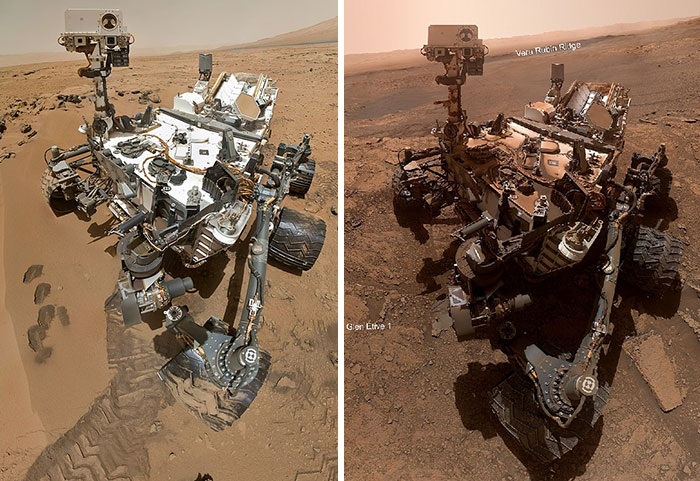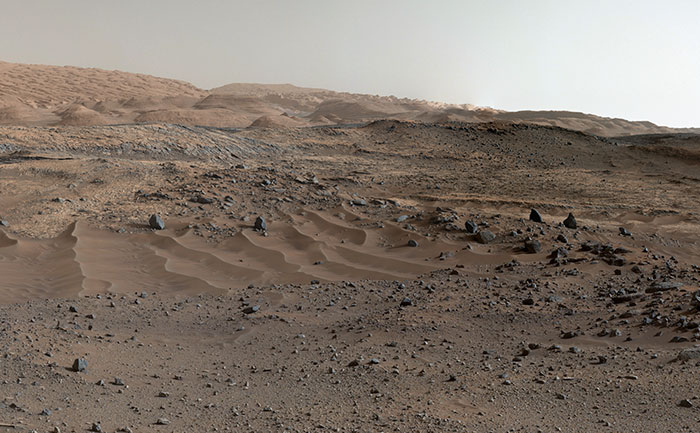
Here Are The 30 Best Photos That NASA’s Curiosity Has Taken After 7 Years On Mars
For a long time, Mars seemed like a frontier that’s untouchable. And while yes, no human has walked on the planet’s red surface, we, as humanity, have reached the planet through the sturdy wheels of Mars rovers. From Sojourner to Spirit, from Opportunity to Curiosity, humanity tried and succeeded to reach and explore the surface of Mars, a meaningful step in our journey to one day leave a human print on another planet. As its predecessors’ missions ended, with Oppy shutting down in 2018, the only Mars rover left on the planet was Curiosity, the little machine that’s been trekking over the wasteland and examining it for nearly 8 years.
Since it is approaching the 8-year mark since landing on the distant planet, Curiosity has managed to collect a rather impressive gallery of photographs through the years. The images give an impressively high-quality look at the red planet and its surface, ranging from dusty planes to rocky mountains.
Here’s how Curiosity looked 7 years ago and now

#1 Ripples On Surface Of Martian Sand Dune

Image source: NASA
#2 Curiosity Rover Finds And Examines A Meteorite On Mars

Image source: NASA
#3 Sunset Sequence In Mars’ Gale Crater

Image source: NASA
#4 Curiosity’s Color View Of Martian Dune After Crossing It

Image source: NASA
#5 Curiosity’s Dusty Selfie At Duluth

Image source: NASA
#6 First Sampling Hole In Mount Sharp

Image source: NASA
#7 Martian Rock ‘Harrison’ In Color, Showing Crystals

Image source: NASA
#8 Multiple Layers Of Mount Sharp

Image source: NASA
#9 Jake Matijevic Rock

Image source: NASA
#10 Curiosity Took Dozens Of Mast Cam Images To Complete This Mosaic Of A Petrified Sand Dune

Image source: marscuriosity
#11 Outcrop In The Murray Buttes Region Of Lower Mount Sharp

Image source: NASA
#12 Curiosity Self-Portrait At Martian Sand Dune

Image source: NASA
#13 Remnants Of Ancient Streambed On Mars

Image source: NASA
#14 Mount Sharp Comes In Sharply

Image source: NASA
#15 Wheel Scuff Mark At ‘Rocknest’

Image source: NASA
#16 Having Reached The Base Of Mount Sharp, Curiosity Captured This Image Of Its Rocky Surroundings

Image source: marscuriosity
#17 View From Mars Orbiter Showing Curiosity Rover At ‘Shaler’

Image source: NASA
#18 Layers At The Base Of Mount Sharp

Image source: NASA
#19 Focusing The 100-Millimeter Mastcam

Image source: NASA
#20 Getting To Know Mount Sharp

Image source: NASA
#21 Curiosity Self-Portrait At ‘Windjana’ Drilling Site

Image source: NASA
#22 Curiosity Visited An Area Named “Fracture Town” Which Contains Many Pointed, Layered Rock Formations

Image source: marscuriosity
#23 Curiosity Arrived At This Active Sand Dune Named “Gobabeb”, Which Is Part Of A Larger Dune Field Known As “Bagnold”

Image source: marscuriosity
#24 Curiosity Rover’s View Of Alluring Martian Geology

Image source: NASA
#25 Mars Rover Curiosity In ‘Buckskin’ Selfie

Image source: NASA
#26 Curiosity Tracks In ‘Hidden Valley’ On Mars

Image source: NASA
#27 A Mudstone Rock Outcrop At The Base Of Mount Sharp

Image source: marscuriosity
#28 Bone Up On Mars Rock Shapes

Image source: NASA
#29 Strata At Base Of Mount Sharp

Image source: NASA
#30 Resistant Features In ‘Pahrump Hills’ Outcrop

Image source: NASA

















Got wisdom to pour?
why i cant left a comment
https://www.extremetech.com/extreme/284725-curiosity-snaps-new-mars-selfie-before-setting-course-for-new-location
NASA uses the Mars Hand Lens Imager (MAHLI) to take these photos. It captures true color images at a resolution of 1600 x 1200. The image released by NASA is much larger than that because it’s stitched together from 57 different frames. That’s why the final image has such amazing detail, and you can’t see the MAHLI arm anywhere. NASA just uses all the frames to crop the arm out, maki
Anyone else curious how the Curiosity takes a selfie photo from what looks to be 8 to 10 feet away with no arms extending out to hold the camera?